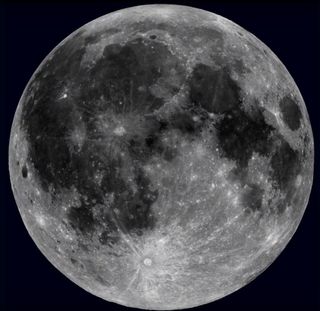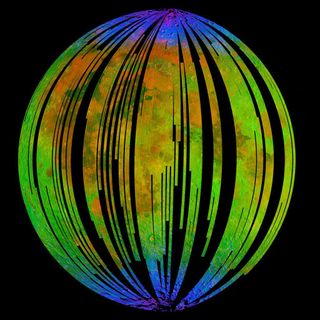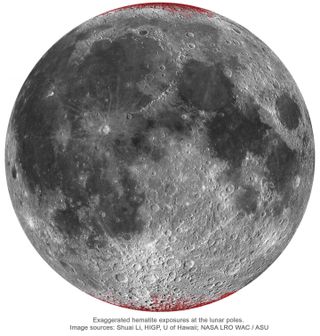The moon is rusty, and it’s likely Earth's fault
No wonder the moon is inching away.

The moon is turning ever so slightly red, and it's likely Earth's fault. Our planet's atmosphere may be causing the moon to rust, new research finds.
Rust, also known as an iron oxide, is a reddish compound that forms when iron is exposed to water and oxygen. Rust is the result of a common chemical reaction for nails, gates, the Grand Canyon's red rocks — and even Mars. The Red Planet is nicknamed after its reddish hue that comes from the rust it acquired long ago when iron on its surface combined with oxygen and water, according to a statement from NASA's Jet Propulsion Laboratory (JPL) in Pasadena, California.
But not all celestial environments are optimal for rusting, especially our dry, atmosphere-free moon.
"It's very puzzling," study lead author Shuai Li, an assistant researcher at the University of Hawaii at Mānoa's Hawaii Institute of Geophysics and Planetology, said in the statement. "The Moon is a terrible environment for [rust] to form in."
Related: In photos: India's Chandrayaan-2 mission to the moon
Li was studying data from the JPL Moon Mineralogy Mapper,which was onboard the Indian Space research Organization's Chandrayaan-1 orbiter while it surveyed the moon in 2008, when he realized that the poles of the moon had very different compositions than the rest of it.

During its mission, the Moon Mineralogy Mapper detected spectra, or wavelengths of light reflected off various surfaces of the moon, to analyze its surface makeup. When Li focused on the poles, he found that the moon's polar surfaces had iron-rich rocks with spectral signatures that matched that of hematite. The mineral hematite, commonly found in Earth's surface, is a specific type of iron oxide, or rust, with the formula Fe2O3.
Get the Space.com Newsletter
Breaking space news, the latest updates on rocket launches, skywatching events and more!
"At first, I totally didn't believe it. It shouldn't exist based on the conditions present on the Moon," co-author Abigail Fraeman, a planetary geoscientist at JPL, said in the statement. "But since we discovered water on the Moon, people have been speculating that there could be a greater variety of minerals than we realize if that water had reacted with rocks."

What on Earth happened
For iron to turn rusty red, it needs what's called an oxidizer — a molecule such as oxygen that removes electrons from a material such as iron. But the sun's solar wind, a stream of charged particles that constantly hits the moon with hydrogen, has the opposite effect. Hydrogen is a reducer, or a molecule that donates electrons to other molecules. Without protection from this solar wind, such as the magnetic field that shields our planet from it, rust should not be able to form on the moon.
But it does, and the key might be our own planet.
The moon doesn't have an atmosphere of its own to provide sufficient amounts of oxygen, but it has trace amounts donated by Earth's atmosphere, according to the statement. This terrestrial oxygen travels to the moon along an elongated extension of the planet's magnetic field called a "magnetotail."
Earth's magnetotail can reach all the way to the near side of the moon, where more of the hematite was found, according to the statement. What's more, at every full moon, the magnetotail blocks 99% of solar wind from blasting the moon, drawing a temporary curtain over the lunar surface, allowing periods of time for rust to form. But there's still one extra ingredient that's needed for rust to form: water.
The moon is mostly devoid of water, save for frozen water found in lunar craters on the moon's far side — far from where most of the hematite was found. But the researchers propose that fast-moving dust particles that bombard the moon might free water molecules locked into the moon's surface layer, allowing the water to mix with the iron. These dust particles might even be carrying water molecules themselves, and their impact might create heat that could increase the oxidation rate, the researchers said.

"This discovery will reshape our knowledge about the Moon's polar regions," Li said in a separate statement from the University of Hawaii. "Earth may have played an important role on the evolution of the Moon's surface."
However, these are still hypotheses and more data is needed to understand exactly why the moon is rusting. Even more surprising, small amounts of hematite have been found on the far side of the moon, which should be too far for Earth's oxygen to hitch a ride on the planet's magnetotail, according to the statement.
The findings were published on Sept. 2 in the journal Science Advances.
Originally published on Live Science.
Join our Space Forums to keep talking space on the latest missions, night sky and more! And if you have a news tip, correction or comment, let us know at: community@space.com.
-
Truthseeker007 I am surprised they aren't blaming it on the humans that the moon is turning slightly red. I guess they wouldn't make much money on that kind of propaganda. About time they blame the Earth for something.:DReply -
IG2007 Reply
Humans are part of the Earth, right?Truthseeker007 said:I am surprised they aren't blaming it on the humans that the moon is turning slightly red. I guess they wouldn't make much money on that kind of propaganda. About time they blame the Earth for something.:D -
Truthseeker007 Reply
I was being sarcastic about the climate change gurus who blame everything on humans. My meaning was even though humans as we are told are not on the moon I am surprised the climate change gurus aren't blaming humans all the way from the Earth. :D You know, they may want to tax us for looking at the moon.:DIG2007 said:Humans are part of the Earth, right? -
Ken Fabian I take more than 3 decades of consistent top level science based advice on climate change seriously - the derision of that advice as "propaganda" and those who advise taking it seriously as "climate change gurus" does not impress me. I think this kind of conspiratorial nonsense does not belong here.Reply -
Cthom84 What am I missing, how is something out side our atmosphere, 384 402 km approx. being affected by it?I'm surprised flat earthers arent jumping on this one.Reply -
Truthseeker007 ReplyKen Fabian said:I take more than 3 decades of consistent top level science based advice on climate change seriously - the derision of that advice as "propaganda" and those who advise taking it seriously as "climate change gurus" does not impress me. I think this kind of conspiratorial nonsense does not belong here.
Did you ever take into account most mainstream scientists are paid off? Much scientific research is funded by government grants, private companies, and non-profit organizations. Cold War propaganda spread the myth that science isn't political. And this Covid has shown that mainstream science is bought and paid for and spreads propaganda and sells you what the Cabal wants you to believe.
Furthermore, John Casey, a former White House space program advisor, climate consultant to NASA and NOAA, and space shuttle engineer, stated the following:
“Global warming is a sham, perpetuated by a network of dirty government officials, greedy corporations, and bought-off scientific organizations.”
Casey’s research revealed government officials deliberately alter climate data to enhance the “global warming”(Climate Change) agenda.
Is climate changing? Sure it is, because the climate has always been changing since the Earth began. Also I don't think you want me to get into Geo-Engineering. -
rod The paper cited in the space.com report, https://advances.sciencemag.org/content/6/36/eaba1940, indicates or suggest the process described here may have been operating over the past, 2.4 billion years. "In addition, a recent study shows that plasmas sourced from Earth’s upper atmosphere (so called “Earth wind”) may have delivered a substantial amount of oxygen to the lunar surface in the past 2.4 billion years during the passage of the Moon through Earth’s magnetotail (7). This terrestrial oxygen could naturally oxidize lunar surface low-valence iron to ferric iron."Reply
2.4 billion years is a short time span compared to the age of the Earth using meteorites and origin of the Moon using Theia impact. The origin of Earth's magnetic field and magnetotail and time it existed is involved here too.


